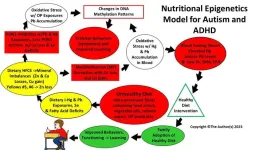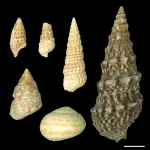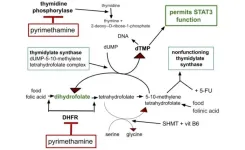(Press-News.org) Research Highlights:
In the EMBOLISE clinical trial, obstructing (or blocking) an artery that supplies blood to the dura, the protective covering of the brain, along with surgery to remove pooled blood reduced the chances by nearly 3-fold that blood would reaccumulate and require additional surgery. According to researchers, complications related to the embolization procedure were low, and neurological function was comparable to those without embolization.
Chronic subdural hematoma, a pooling of blood between the brain and one of its outer coverings, is one of the most common reasons for neurosurgery and is especially frequent in the elderly because of structural changes in the brain that occur with aging and the increasing use of blood thinners.
Embargoed until 11:18 a.m. MT/1:18 p.m. ET Friday, Feb. 9, 2024
PHOENIX, Feb. 9, 2024 — Injection of a substance to block an artery feeding the dura (protective sack around the brain) along with surgery to remove pooled blood reduced the risk that patients will require repeat surgery compared to surgical drainage alone, according to preliminary late-breaking science presented today at the American Stroke Association’s International Stroke Conference 2024. The meeting, held in person in Phoenix Feb. 7 - 9, 2024, is a world premier meeting for researchers and clinicians dedicated to the science of stroke and brain health.
A subdural hematoma occurs when there is a tear in one of the thin blood vessels that stretch between the surface of the brain and the overlying membranes that protect the brain. A subdural hematoma can occur because of physical trauma such as a car accident, however, it may also develop slowly in the days or weeks after the injury. This study explored treatment for subacute or chronic subdural hematoma. Subacute subdural hematoma occurs following less severe trauma, such as a concussion – with symptoms such as weakness, numbness, tingling, seizure, headache, confusion or dizziness that develops over hours or days after the event. Chronic subdural hematoma can result from slow bleeding after minimal trauma that the patient may not even remember – symptoms may be subtle and/or may take weeks to be noticeable enough to seek treatment.
“Chronic subdural hematoma is one of the most common neurosurgical conditions and is likely to increase in the future since we have a sizeable aging population, with many taking blood thinners to manage various medical conditions,” said study co-author Jason Davies, M.D., Ph.D., an associate professor in the departments of neurosurgery and biomedical informatics at the State University of New York, Buffalo. “These hematomas often form in the elderly because as we age, the brain shrinks and pulls away from the inside of the skull, stretching the veins that form a bridge between the dura and the brain, which makes them more likely to tear after a small trauma and leak blood into the protective space between the brain and skull, the dura.”
Treatment for subacute or chronic subdural hematoma may involve a surgical procedure to drain pooled blood from the area or closely monitoring symptoms to determine if and when intervention may be necessary. The challenge is that even with surgery, repeat surgery may be needed in up to 20% of cases of subdural hematomas.
The EMBOLISE clinical trial tested whether a subacute or chronic subdural hematoma is less likely to require additional surgery if, in addition to surgical drainage, a substance is injected to block, or embolize, one of the arteries supplying blood to the dura. The OnyxTM liquid embolic system, tested in this trial, is already used prior to surgery to reduce bleeding in people having an operation to correct an abnormal connection between arteries and veins in the brain.
Between December 2020 and August 2023, researchers enrolled 400 adults (average age of 72; 27% women) at 39 centers (including both community and academic hospitals). All were about to undergo surgery for subacute or chronic subdural hematoma and were considered able to care for themselves and likely to survive at least one year. Patients were randomly assigned to receive either surgery alone or surgery plus embolization using the liquid embolic system to help reduce the progression or recurrence of subdural hematoma.
The primary outcome was how frequently there was reaccumulation of blood (a recurrence) that required surgical drainage within 90 days.
The analysis found:
Subsequent subdural hematoma within 90 days and need for surgical drainage occurred in 4.1% of patients who had surgery plus embolization and 11.3% of those who had surgery alone.
At 90 days after surgery, increasing disability and neurological dysfunction was found to be comparable (statistically the same) in both groups, with 11.9% of patients who had surgery plus embolization and 9.8% of patients who had surgery alone.
Serious adverse events attributed to embolization occurred in 2% of patients who received it.
“The EMBOLISE trial showed that there was a nearly 3-fold reduction in re-operation for patients that were treated with surgery plus embolization,” Davies said. “Fewer trips to the operating room mean less potential for pain, complications, recovery and expense for the patient. Furthermore, we see that the complications related to the embolization procedure were low and that there was no increase in neurological problems.”
Study details and background:
The EMBOLISE (Embolization of the Middle Meningeal Artery With OnyxTM Liquid Embolic System in the Treatment of Subacute and Chronic Subdural Hematoma) study was conducted at multiple hospitals and health centers in the United States.
The liquid embolic system treatment starts as an injectable soft solid, flows as a liquid when force is applied, and then returns to a soft solid state to stop the leaking blood vessel.
Other arms of the EMBOLISE study, which included patients not undergoing surgery and randomized to either receive the liquid embolic system or not, are ongoing and not being presented at ISC 2024.
Additional measures to gauge success of the liquid embolic system treatment included the number of hospital readmissions; change in hematoma (pooling of blood) volume or thickness; and change in midline shift (when a hematoma pushes brain tissue out of alignment), all assessed at 90 days after treatment.
Safety endpoints included the incidence of neurological death or serious adverse events occurring within 30, 90 and 180 days after treatment.
The main limitation was a relatively high loss to follow up. “One of the challenges of conducting this trial was dealing with a frail elderly population, especially in the middle of the pandemic. Tracking patients down for follow up is always a challenge, and these were compounded by the various COVID-era restrictions that many of our sites faced,” Davies said.
Co-authors and disclosures are listed in the abstract.
The study was funded by Medtronic Neurovascular Clinical Affairs. The OnyxTM Liquid Embolic System is manufactured EV3, which is owned by Medtronic.
Statements and conclusions of studies that are presented at the American Heart Association’s scientific meetings are solely those of the study authors and do not necessarily reflect the Association’s policy or position. The Association makes no representation or guarantee as to their accuracy or reliability. Abstracts presented at the Association’s scientific meetings are not peer-reviewed, rather, they are curated by independent review panels and are considered based on the potential to add to the diversity of scientific issues and views discussed at the meeting. The findings are considered preliminary until published as a full manuscript in a peer-reviewed scientific journal.
The Association receives funding primarily from individuals; foundations and corporations (including pharmaceutical, device manufacturers and other companies) also make donations and fund specific Association programs and events. The Association has strict policies to prevent these relationships from influencing the science content. Revenues from pharmaceutical and biotech companies, device manufacturers and health insurance providers and the Association’s overall financial information are available here.
Additional Resources:
Multimedia is available on the right column of the release link https://newsroom.heart.org/news/blocking-artery-supplying-the-brain-covering-after-subdural-hematoma-reduced-repeat-surgery?preview=9c2cbd1b56ca98e3eef02321aa3f3e8e
After Feb. 7, view LB28 in the ASA International Stroke Conference 2024 Online Program Planner
AHA news release: In first in-utero brain surgery, doctors eliminated symptoms of dangerous condition (May 2023)
For more news at ASA International Stroke Conference 2024, follow us on X (formerly known as Twitter) @HeartNews #ISC24
###
About the American Stroke Association
The American Stroke Association is devoted to saving people from stroke — the No. 2 cause of death in the world and a leading cause of serious disability. We team with millions of volunteers to fund innovative research, fight for stronger public health policies and provide lifesaving tools and information to prevent and treat stroke. The Dallas-based association officially launched in 1998 as a division of the American Heart Association. To learn more or to get involved, call 1-888-4STROKE or visit stroke.org. Follow us on Facebook, X.
END
Blocking artery supplying the brain covering after subdural hematoma reduced repeat surgery
American Stroke Association International Stroke Conference – Late-Breaking Science Presentation LB 28
2024-02-09
ELSE PRESS RELEASES FROM THIS DATE:
Robotic-assisted surgery and navigation don't affect infection risk after hip arthroplasty
2024-02-09
Waltham — February 8, 2024 — For patients undergoing total hip arthroplasty (THA), the use of robotic-assisted surgery and surgical navigation techniques is not associated with an increased risk of periprosthetic joint infection (PJI), suggests a study in The Journal of Bone & Joint Surgery. The journal is published in the Lippincott portfolio by Wolters Kluwer.
Computer navigation (CN) and robotic assistance (RA) do not alter the risk of PJI after total hip replacement surgery, according to the new research by Alberto V. Carli, MD, and colleagues of Hospital for Special Surgery, New York.
Could CN and RA increase risks during hip replacement?
Computer ...
New study shows nutritional epigenetics education improves diet and attitude in parents of children with autism and ADHD
2024-02-09
In a recent publication released by PubMed, American scientists led by Dr. Dufault at the Food Ingredient and Health Research Institute, reported the results of a clinical trial in which parents who received nutritional epigenetics education significantly reduced their consumption of ultra-processed foods while increasing their intake of whole and/or organic foods. The education intervention used curriculum focused on the constructs of the nutritional epigenetics model that explains how autism and attention deficit/hyperactivity disorder (ADHD) may develop from the excess consumption of ultra-processed ...
Immune genes are altered in Alzheimer’s patients’ blood
2024-02-09
· First-of-its-kind study of immune genes in Alzheimer’s patients’ blood
· Immune T cells are altered and entering brain
· Uncertain whether changes precipitate the disease
CHICAGO --- A new Northwestern Medicine study has found the immune system in the blood of Alzheimer’s patients is epigenetically altered. That means the patients’ behavior or environment has caused changes that affect the way their genes work.
Many of these altered immune genes are the same ones that increase an ...
The Biophysical Journal names Erdinc Sezgin the 2023 Paper of the Year-Early Career Investigator Awardee
2024-02-09
ROCKVILLE, MD – Erdinc Sezgin, of Karolinska Institutet, Sweden will be honored as the recipient of the Biophysical Journal Paper of the Year-Early Career Investigator Award at the 68th Annual Meeting of the Biophysical Society, held February 10-14 in Philadelphia, Pennsylvania. This award recognizes the work of outstanding early career investigators in biophysics. The winning paper is titled “Influence of the Extracellular Domain Size on the Dynamic Behavior of Membrane Proteins.” The paper was published in Volume 121, Issue ...
Research reveals the key to an irresistible online dating profile
2024-02-09
In writing a good online dating profile, the average love-seeker is likely to fill it up with all the appealing qualities and interests that make them special. They paraglide and do hot yoga on the weekends; enjoy Riesling on the beach or seeing indie bands in basements; are a Libra with Scorpio rising; or have a dog or three kids or an iguana. There’s one thing they routinely leave out, however: what they want to know about their potential partner.
Yet, that detail might the most important thing to include, according ...
Surprisingly vibrant colour of 12-million-year-old snail shells
2024-02-09
Snail shells are often colourful and strikingly patterned. This is due to pigments that are produced in special cells of the snail and stored in the shell in varying concentrations. Fossil shells, on the other hand, are usually pale and inconspicuous because the pigments are very sensitive and have already decomposed. Residues of ancient colour patterns are therefore very rare. This makes this new discovery by researchers from the University of Göttingen and the Natural History Museum Vienna (NHMW) all the more astonishing: they found pigments in ...
In the Cerrado, crop diversification has beneficial effects on wildlife and reduces the presence of boars
2024-02-09
There are no substitutes for native vegetation, but replacing large areas of monoculture with diversified crops in places where agricultural activities are widespread can have beneficial effects on the mammals that still inhabit the region.
This is one of the conclusions of a study conducted by researchers at the University of São Paulo (USP) supported by FAPESP. They focused on the northeast of São Paulo state, where the predominant biome is the Cerrado (Brazilian savanna). The region is one of the nation’s agribusiness centers.
An article on the study is published in the Journal of Applied Ecology. The study showed that ...
How electron spectroscopy measures exciton “holes”
2024-02-09
Semiconductors are ubiquitous in modern technology, working to either enable or prevent the flow of electricity. In order to understand the potential of two-dimensional semiconductors for future computer and photovoltaic technologies, researchers from the Universities of Göttingen, Marburg and Cambridge investigated the bond that builds between the electrons and holes contained in these materials. By using a special method to break up the bond between electrons and holes, they were able to gain a ...
IPIAD: an augmentation to standard treatment of PDAC using five repurposed drugs
2024-02-09
“This paper presents the rationale for adding five already approved and marketed generic drugs from general medical practice to the current standard current first line chemotherapy for pancreatic ductal adenocarcinoma (PDAC).”
BUFFALO, NY- February 9, 2024 – A new research perspective was published in Oncoscience (Volume 11) on February 7, 2024, entitled, “IPIAD- an augmentation regimen added to standard treatment of pancreatic ductal adenocarcinoma using already-marketed repurposed drugs irbesartan, pyrimethamine, itraconazole, azithromycin, and dapsone.”
In this new paper, researcher Richard E. Kast from IIAIGC Study Center presents the ...
UT Health San Antonio School of Dentistry opens dental clinic for special-needs children, adults
2024-02-09
SAN ANTONIO, Feb. 9, 2024 – The UT Health San Antonio School of Dentistry has opened a special-care dental clinic, the first of its kind in an academic setting in South Texas that will serve people of all ages with intellectual, developmental, cognitive or physical disabilities.
With spacious, specially designed treatment rooms featuring adjustable sound and lighting and even a “Zen Den” multi-sensory room to help reduce anxiety, the Phil and Karen Hunke Special Care Clinic occupies approximately ...
LAST 30 PRESS RELEASES:
iPS cells from dish to freezer and back
Deep neural networks enable accurate pricing of American options under stochastic volatility
Collective risk resonance in Chinese stock sectors uncovered through higher-order network analysis
Does CPU impact systemic risk contributions of Chinese sectors? Evidence from mixed frequency methods with asymmetric tail long memory
General intelligence framework to predict virus adaptation based on a genome language model
Antibiotic resistance is ancient, ecological, and deeply connected to human activity, new review shows
Vapes, pouches, heated tobacco, shisha, cigarettes: nicotine in all forms is toxic to the heart and blood vessels
From powder to planet: University of Modena engineers forge a low-carbon future for advanced metal manufacturing
Super strain-resistant superconductors
Pre-school health programme does not improve children’s diet or physical activity, prompting call for policy changes, study finds
Autumn clock change linked to reduction in certain health conditions
AI images of doctors can exaggerate and reinforce existing stereotypes
Where medicine meets melody – how lullabies help babies and parents in intensive care
We may never be able to tell if AI becomes conscious, argues philosopher
AI video translation shows promise but humans still hold the edge
Deep ocean earthquakes drive Southern Ocean’s massive phytoplankton blooms, study finds
Without campus leftovers to pick through, the beaks of this bird changed shape during the pandemic
High-dose antibiotic does not reduce mortality in tuberculous meningitis
How many insects fly in the sky above the USA?
Could cheese protect your brain health?
Who faces more difficulty recovering from stroke?
Colliding galaxies create the brightest, fastest growing black holes at their center
New BrainHealth research reveals tradeoffs on sleep with cannabis use for chronic pain
Aging-US now on ResearchGate, enhancing visibility for authors and readers
'Molecular glue' stabilizes protein that inhibits development of non-small cell lung cancer
Mount Sinai Health System is recognized in 2025 Chime Digital Health Most Wired survey
From prey to predator: How carnivores spread beneficial fungi
Menopause symptoms may be frequent and have negative effects, according to female endurance athletes
US Congressmembers’ responses on X to mass shooting events differ along party lines
KAIST-UEL team develops “origami” airless wheel to explore lunar caves
[Press-News.org] Blocking artery supplying the brain covering after subdural hematoma reduced repeat surgeryAmerican Stroke Association International Stroke Conference – Late-Breaking Science Presentation LB 28




